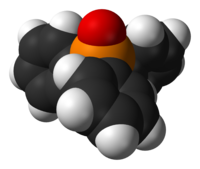Triphenylphosphine oxide
 |
|
 |
|
 |
|
| Names | |
|---|---|
|
Preferred IUPAC name
Triphenyl-λ5-phosphanone
|
|
| Other names
Triphenylphosphine oxide
|
|
| Identifiers | |
|
3D model (JSmol)
|
|
| ChEBI | |
| ChemSpider | |
| ECHA InfoCard | 100.011.217 |
|
PubChem CID
|
|
| RTECS number | SZ1676000 |
|
|
|
|
| Properties | |
| C18H15OP | |
| Molar mass | 278.29 g/mol |
| Appearance | white crystals |
| Melting point | 154 to 158 °C (309 to 316 °F; 427 to 431 K) |
| Boiling point | 360 °C (680 °F; 633 K) |
| low | |
| Solubility in other solvents | polar organic solvents |
| Structure | |
| tetrahedral | |
| Hazards | |
| Main hazards | slight |
| R-phrases (outdated) | 22-36/37/38 |
| S-phrases (outdated) | 26 |
| Related compounds | |
|
Related compounds
|
P(C6H5)3S; |
|
Except where otherwise noted, data are given for materials in their standard state (at 25 °C [77 °F], 100 kPa).
|
|
|
|
|
| Infobox references | |
Triphenylphosphine oxide (often abbreviated TPPO) is the chemical compound with the formula OP(C6H5)3, also written as Ph3PO or PPh3O (Ph = C6H5). This colourless crystalline compound is a common side product in reactions involving triphenylphosphine. It is a popular reagent to induce the crystallizing of chemical compounds.
Ph3PO is tetrahedral molecule related to POCl3. The oxygen center is relatively basic. The rigidity of the backbone and the basicity of the oxygen center make this species a popular agent to crystallize otherwise difficult to crystallize molecules. This trick is applicable to molecules that have acidic hydrogen atoms, e.g. phenols.
Ph3PO is a by-product of many useful reactions in organic synthesis including the Wittig, Staudinger, and Mitsunobu reactions. It is also formed when PPh3Cl2 is employed to convert alcohols into alkyl chlorides.
Triphenylphosphine can be regenerated from the oxide by treatment with trichlorosilane.
Triphenylphosphine oxide can be difficult to remove from reaction mixtures by means of chromatography. It is poorly soluble in hexane and cold diethyl ether. Trituration or chromatography of crude products with these solvents often leads to a good separation of triphenylphosphine oxide. One tip for its removal is to form its Mg(II) complex, which is poorly soluble in toluene or dichloromethane and can be filtered off. See WO 1998007724.
Ph3PO is an excellent ligand for "hard" metal centers. A typical complex is the tetrahedral species NiCl2(OPPh3)2.
...
Wikipedia
